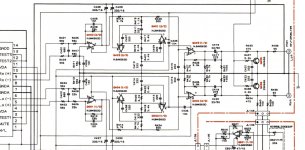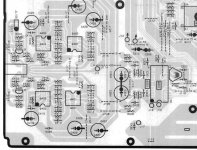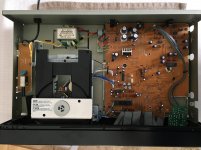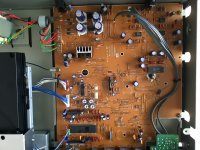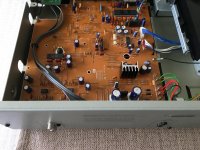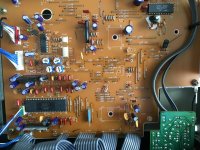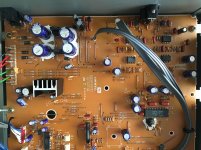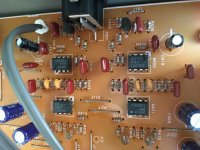Hi guys,
I recently purchased a used Onkyo DX-710 (1993) CD player. It's a decent unit but i think its sound is a bit shrill, strident and steely at times (especially with female vocals) which makes it often unpleasant listening.
I would like to ask for advice whether I could get something better out of this CD player by some Op Amps rolling there...
I opened up the unit and I see a bunch of transistors laying around as well as four (!) NJM4560DX op amps (DIP-8) near the RCA outputs.
However I don't have the technical expertise to decide whether those 4 Op Amps are related to the analog signal processing at all (i guess they are but that's just my guess) or there may be other components doing that, or both.
I thought to upload here the schematics, block diagrams and Printed Circuit Board drawing plus the parts values, maybe someone could identify and advise the best route on this for me.
The 4 NJM4560DX op amps are marked as Q401, Q402, Q403 and Q404 in the service manual.
I also found close to them the capacitors C425, C426 which are 0.1μF and appear to be bypass caps maybe (i found continuity of those caps with pins 4 and 8 of all those 4 Op Amps), maybe there are more ...
If any of those Op Amps worth to replace, I'd wanted to kindly ask whether modern Op Amps would fit the circuit (NJMs have quite low slew rate and frequency compared to newer Op Amp designs as far as I can see..)
I'd appreciate any help, if you need more information from my side I'd be happy to provide it.
I recently purchased a used Onkyo DX-710 (1993) CD player. It's a decent unit but i think its sound is a bit shrill, strident and steely at times (especially with female vocals) which makes it often unpleasant listening.
I would like to ask for advice whether I could get something better out of this CD player by some Op Amps rolling there...
I opened up the unit and I see a bunch of transistors laying around as well as four (!) NJM4560DX op amps (DIP-8) near the RCA outputs.
However I don't have the technical expertise to decide whether those 4 Op Amps are related to the analog signal processing at all (i guess they are but that's just my guess) or there may be other components doing that, or both.
I thought to upload here the schematics, block diagrams and Printed Circuit Board drawing plus the parts values, maybe someone could identify and advise the best route on this for me.
The 4 NJM4560DX op amps are marked as Q401, Q402, Q403 and Q404 in the service manual.
I also found close to them the capacitors C425, C426 which are 0.1μF and appear to be bypass caps maybe (i found continuity of those caps with pins 4 and 8 of all those 4 Op Amps), maybe there are more ...
If any of those Op Amps worth to replace, I'd wanted to kindly ask whether modern Op Amps would fit the circuit (NJMs have quite low slew rate and frequency compared to newer Op Amp designs as far as I can see..)
I'd appreciate any help, if you need more information from my side I'd be happy to provide it.
Attachments
OK, attached are photos of the output stage schematics and circuit board (for easier view by forum readers).
Yes, the four opamps are related t the analogue output stage.
In my humble opinion yes, the sound could be improved by:
a) some rather simple steps (i.e. without any major rebuild);
b) alternatively introducing DOS output stage (probably both output stages - DOS and the original one) can be accommodated in the player).
The practical problem is that you admit to lack expertise in the electronics field but these actions require some manual soldering and player disassembly/assembly skills (even when following step by step advice).
Could you upload some photos of the player internals (audio board)?
And what are you comparing this player to? I.e. what is the reference player?
Yes, the four opamps are related t the analogue output stage.
In my humble opinion yes, the sound could be improved by:
a) some rather simple steps (i.e. without any major rebuild);
b) alternatively introducing DOS output stage (probably both output stages - DOS and the original one) can be accommodated in the player).
The practical problem is that you admit to lack expertise in the electronics field but these actions require some manual soldering and player disassembly/assembly skills (even when following step by step advice).
Could you upload some photos of the player internals (audio board)?
And what are you comparing this player to? I.e. what is the reference player?
Attachments
Hi,
I have no issues working with soldering (recently built 3 phono preamps and soldered opa1656 SOIC-8 chips onto browndog adapters 🙂 ), neither with player disassembly (actually I'm preparing to replace the laser pickup unit on this cd player later today).
I just have difficulty to read complicated schematics like these ones and understand what each component does and why...
My reference player is a Marantz CD6000 OSE but i would not be fair to compare this Onkyo with the Marantz.
I do compare it with another budget 5-disk CD player I found at the local goodwill (Sony CDP-C345) , and that Sony sound is much more balanced than this Onkyo.
Simply I would like to keep this Onkyo as my everyday player.
(The Marantz is still in my possession but far far away.)
Uploaded the photos of the player internals...please let me know if everything else needed from my side and thank you so much for helping out!
EDIT: Please right-click and open the photos in a new tab to view the actual full size of it.
I have no issues working with soldering (recently built 3 phono preamps and soldered opa1656 SOIC-8 chips onto browndog adapters 🙂 ), neither with player disassembly (actually I'm preparing to replace the laser pickup unit on this cd player later today).
I just have difficulty to read complicated schematics like these ones and understand what each component does and why...
My reference player is a Marantz CD6000 OSE but i would not be fair to compare this Onkyo with the Marantz.
I do compare it with another budget 5-disk CD player I found at the local goodwill (Sony CDP-C345) , and that Sony sound is much more balanced than this Onkyo.
Simply I would like to keep this Onkyo as my everyday player.
(The Marantz is still in my possession but far far away.)
Uploaded the photos of the player internals...please let me know if everything else needed from my side and thank you so much for helping out!
EDIT: Please right-click and open the photos in a new tab to view the actual full size of it.
Attachments
Last edited:
OK, two next questions:
- how important for you is the "blackness of digital silence"? Background of the question is that the DOS output stage increases probably the general noise floor a bit, the question is - can you hear it and is it that important for you.
- have you ever tested listening to different opamps in some simple (one chip) test device? I.e. do you have any preference among the opamps.
- how important for you is the "blackness of digital silence"? Background of the question is that the DOS output stage increases probably the general noise floor a bit, the question is - can you hear it and is it that important for you.
- have you ever tested listening to different opamps in some simple (one chip) test device? I.e. do you have any preference among the opamps.
Why not fit some sockets and then you can try some different opamps. I'm going to suggest you try the old TL072 FET opamp. Although old these devices offer excellent audio performance and were the device of choice many moons ago.
If anything is going to take an edge of things and offer a more rounded performance then I think it would be something like these.
These device are often criticised for poor drive ability but I would argue that you should put some numbers into that first... the CD player will put out at most around 3 volts peak and so given an output current of say 10 milliamps that means you can drive 300 ohm load. So no problem at all there.
Others to try would be the OPA2134 series and there are countless others as well.
If anything is going to take an edge of things and offer a more rounded performance then I think it would be something like these.
These device are often criticised for poor drive ability but I would argue that you should put some numbers into that first... the CD player will put out at most around 3 volts peak and so given an output current of say 10 milliamps that means you can drive 300 ohm load. So no problem at all there.
Others to try would be the OPA2134 series and there are countless others as well.
I'm going to suggest you try the old TL072 FET opamp.
About a year ago I had a free afternoon and did a listening test of a (roughly) dozen opamps from my "drawers" (using a Marantz CD-67 as a test rig) - TL072 sounded surprisingly in the top ranks but TL082 sounded just a tiny bit better.
Edit: I forgot to mention that before swapping the opamps I would fix their power rails, remove the muting transistors from the signal path and replace the output capacitors with film capacitors (Wima MKS being the cheapest option probably).
Last edited:
@madis64
Let me answer to the second question and then continue with the first:
- I have listened to different Op Amps while I was building the Elliot's ESP Phono Preamp and the Muffsy Phono preamp.
I have listened so far to these Op Amps:
NE5532 (TI)
LM4562 (TI)
opa2134 (TI)
AD823 (Analog Devices)
ADA4625-2 (Analog Devices)
AD8620 (Analog Devices)
opa1656 (TI)
- Of all the above the only Op Amp that's accused for higher noise is the AD823.
To my system, I have to turn the volume all the way up to 4 (from a scale 0 t 10) or above that, to be able hear that noise and while music was NOT playing.
If music was playing, that would be an unsustainable volume level for me. I usually listen to 1.5 or 2 and when I want to "rock" I pump the volume up to 3. But even at 3 I have to be alone in the house otherwise my relatives would complain for the music being too loud.
With that said, Op Amp NOISE is a rather controversial subject for me as far as it concerns real life experience (listening to the music) over measuring Op Amps with electronic instruments...
I didn't care for AD823 noise out of my ESP phono preamp (because I can't listen that loud at the point where the noise would become seriously audible),
I don't think I will care for Onkyo DX710 slight higher noise.
(Please explain what DOS output is and what DOS stands for in this case.)
Back on topic, I have settled with opa1656 in my ESP phono preamp until a quad of ADA4627-1 arrives next week.
I was thinking, as Mooly said, to fit DIP8 sockets in place of the Onkyo DX710 NJM op amps and listen to opa1656 for starters.
However, as I said earlier, modern Op Amps usually have higher bandwidth and higher slew rate than those old NJMs, so that might be a show stopper?
@Mooly,
totally agree, just want to make sure I can actually "perform" an op amp rolling in that circuit without risking any damage to the circuit because of different characteristics of the modern op amps against those NMJ ...
Let me answer to the second question and then continue with the first:
- I have listened to different Op Amps while I was building the Elliot's ESP Phono Preamp and the Muffsy Phono preamp.
I have listened so far to these Op Amps:
NE5532 (TI)
LM4562 (TI)
opa2134 (TI)
AD823 (Analog Devices)
ADA4625-2 (Analog Devices)
AD8620 (Analog Devices)
opa1656 (TI)
- Of all the above the only Op Amp that's accused for higher noise is the AD823.
To my system, I have to turn the volume all the way up to 4 (from a scale 0 t 10) or above that, to be able hear that noise and while music was NOT playing.
If music was playing, that would be an unsustainable volume level for me. I usually listen to 1.5 or 2 and when I want to "rock" I pump the volume up to 3. But even at 3 I have to be alone in the house otherwise my relatives would complain for the music being too loud.
With that said, Op Amp NOISE is a rather controversial subject for me as far as it concerns real life experience (listening to the music) over measuring Op Amps with electronic instruments...
I didn't care for AD823 noise out of my ESP phono preamp (because I can't listen that loud at the point where the noise would become seriously audible),
I don't think I will care for Onkyo DX710 slight higher noise.
(Please explain what DOS output is and what DOS stands for in this case.)
Back on topic, I have settled with opa1656 in my ESP phono preamp until a quad of ADA4627-1 arrives next week.
I was thinking, as Mooly said, to fit DIP8 sockets in place of the Onkyo DX710 NJM op amps and listen to opa1656 for starters.
However, as I said earlier, modern Op Amps usually have higher bandwidth and higher slew rate than those old NJMs, so that might be a show stopper?
@Mooly,
totally agree, just want to make sure I can actually "perform" an op amp rolling in that circuit without risking any damage to the circuit because of different characteristics of the modern op amps against those NMJ ...
Please explain what DOS output is and what DOS stands for in this case.
DOS stands (in this CD-player mods context) for Discrete Output Stage:
Ray's Audio Page
- very few transistors doing a very nice job (I have it in both my main CD-67 and also in Pioneer N-50 network player)...
If you are willing to go deeper into the subject then here is the 21k posts "mother thread" to work through in your idle afternoons 😉 :
Marantz CD63 & CD67 mods list
Last edited:
Hi, i went through that post about cd63 mods a few days ago. But doesn't help much in my onkyo case.
So, what's the outcome?
-Can i try modern op amps to replace those NJM ones?
-Should i stick with replacing those with other old op amps as Mooly suggested?
-should i not replace them at all?
And in the end, if i go with replacing them, what are the electrical characteristics i should care to match?
Also should i replace all 4 of them or just 2 of them, or?
So, what's the outcome?
-Can i try modern op amps to replace those NJM ones?
-Should i stick with replacing those with other old op amps as Mooly suggested?
-should i not replace them at all?
And in the end, if i go with replacing them, what are the electrical characteristics i should care to match?
Also should i replace all 4 of them or just 2 of them, or?
Answers below are from my personal pretty amateuristic experience (covering many modified devices though), probably there are many more knowledgeable people around to provide more insight:
I have replaced the oldtimers with pretty much anything that will tolerate the power rails voltage - to prevent oscillation of the faster opamps I have soldered a 100nF film capacitor (perhaps also a ceramic of better sort will also do) over the power pins 4 and 8 (straight on the underside of the circuit board).
I personally have met no problems so far.
Yes, the change in sound can be audible.
I would play around with all of them - but they do serve a bit different purpose - the first one is for amplifying (and joining together) the signal from dac outputs, the second one should drive the cable (if the signal cable is short with ca 100pF/m capacitance then the load on the output buffer should not be significant - provided you do not have major capacitance across the inputs in your amplifier).
The fact that Onkyo has decided to use 50% of each of these chips as part of the signal filter is "a quirk of the model to live with" - some players have these filters on passives, some use opamps.
Can i try modern op amps to replace those NJM ones?
I have replaced the oldtimers with pretty much anything that will tolerate the power rails voltage - to prevent oscillation of the faster opamps I have soldered a 100nF film capacitor (perhaps also a ceramic of better sort will also do) over the power pins 4 and 8 (straight on the underside of the circuit board).
I personally have met no problems so far.
-Should i stick with replacing those with other old op amps as Mooly suggested?
Yes, the change in sound can be audible.
Also should i replace all 4 of them or just 2 of them, or?
I would play around with all of them - but they do serve a bit different purpose - the first one is for amplifying (and joining together) the signal from dac outputs, the second one should drive the cable (if the signal cable is short with ca 100pF/m capacitance then the load on the output buffer should not be significant - provided you do not have major capacitance across the inputs in your amplifier).
The fact that Onkyo has decided to use 50% of each of these chips as part of the signal filter is "a quirk of the model to live with" - some players have these filters on passives, some use opamps.
Ok thank you. Just to clarify:
In case of modern op amps and to prevent oscillation,
i should connect 1 capacitor, one leg of the capacitor to pin 4 of the op amp
and the other leg to pin 8, right?
I'm asking this because i read in another forum 2 capacitors needed with the following connections:
Capacitor 1, connect one leg to op amp pin 4 and the other to ground.
Capacitor 2, connect one leg to op amp pin 8 and the other to ground.
In case of modern op amps and to prevent oscillation,
i should connect 1 capacitor, one leg of the capacitor to pin 4 of the op amp
and the other leg to pin 8, right?
I'm asking this because i read in another forum 2 capacitors needed with the following connections:
Capacitor 1, connect one leg to op amp pin 4 and the other to ground.
Capacitor 2, connect one leg to op amp pin 8 and the other to ground.
Ok thank you. Just to clarify:
In case of modern op amps and to prevent oscillation,
i should connect 1 capacitor, one leg of the capacitor to pin 4 of the op amp
and the other leg to pin 8, right?
I'm asking this because i read in another forum 2 capacitors needed with the following connections:
Capacitor 1, connect one leg to op amp pin 4 and the other to ground.
Capacitor 2, connect one leg to op amp pin 8 and the other to ground.
Never-mind,
I found the answer in that thread Op-amp decoupling - best practice? and as it seems there is no clear answer to my question as this op-amp decouling (or bypassing) to avoid oscillation is on a per-case basis task.
I will first try with Op Amps which have as close as possible characteristics with the NJM4560D which are in this Onkyo 710 CD player and take it from there...
I have studied op amp comparison tables of both TI and Analog Devices this evening (crap, 3 hours spent there) and I plan to order these to experiment with:
AD8599
AD8672
ADA4075-2 and
from TI OPA1642.
Preparing myself mentally for an exhaustive soldering session of those SOIC op amps to my browndog SOIC-8 to DIP-8 adapters under the magnifying 2x work light.
Let the force be with my (steady-wannabe) hands...
Will report back with sound results.

....................TL072 sounded surprisingly in the top ranks but TL082 sounded just a tiny bit better.
The TL082 has slightly higher noise than the TL072 and although counter intuitive you could argue that noise could mask low level dither in a D/A stage (doing the I/V conversion). What sounds best isn't always about numbers.
Using a FET device also removes the possibility of the opamps front end doing unwanted things in the presence of all that HF noise and hash in a DAC.
@Mooly,
totally agree, just want to make sure I can actually "perform" an op amp rolling in that circuit without risking any damage to the circuit because of different characteristics of the modern op amps against those NMJ ...
Provided you make sure you fit pin for pin compatible parts (so no singles for duals by mistake) and that they are suitably rated for the voltages in the player then you will not cause damage. That doesn't mean every device will be suitable, it won't, but you won't damage anything.
... as it seems there is no clear answer to my question as this op-amp decouling (or bypassing) to avoid oscillation is on a per-case basis task.
Yes, there seems to be more than one way "to get away with it" but - using common sense:
- reservoire caps are usually centimeters away from the IC chips so even if they are bridged with 100...200nF caps (to kill the oscillations) there is still some distance to cover and they are shared usually by more than one chip;
- you can also find modding photos where the decoupling caps have been soldered on top of the chip directly to the power pins.
- you can also find modding pics where both kinds of decoupling caps have been introduced.
So one does not exclude the other and these caps do not cost much then - once the board is out of the player - I would solder in the 100nF caps both across the reservoire caps and across the chip socket pins (under the board).
I took a look to schemes.
NJM4560D (Q401, 402, 403 404) are dual OPAMP. Seems you are used with browndog adapters. OK. Just try different ones and trust your ears.
Begin with 5532!
Their power supply is +/-5V (Q903/Q904 - 78M05L/79M05L). Which seems low (IMHO). Their typical voltage is +/- 15 V (from datasheet). I may suggest you to replace them with 78M15L/79M15L or 78M12L/79M12L.
DC blocking caps are C419/417 and C420/418 (22µ/27n). You can replace them with "better" ones as Elna, Muse, MKT, MKP,...
But, IMHO, the more important is to replace Q901 (78M05L), regulator with heatsink.
Its output currant is up to 0.5A. You can replace it with LT3045.
NJM4560D (Q401, 402, 403 404) are dual OPAMP. Seems you are used with browndog adapters. OK. Just try different ones and trust your ears.
Begin with 5532!
Their power supply is +/-5V (Q903/Q904 - 78M05L/79M05L). Which seems low (IMHO). Their typical voltage is +/- 15 V (from datasheet). I may suggest you to replace them with 78M15L/79M15L or 78M12L/79M12L.
DC blocking caps are C419/417 and C420/418 (22µ/27n). You can replace them with "better" ones as Elna, Muse, MKT, MKP,...
But, IMHO, the more important is to replace Q901 (78M05L), regulator with heatsink.
Its output currant is up to 0.5A. You can replace it with LT3045.
There is insufficient raw DC available to use 12 volt regulators for the analogue stages even if you wanted to, in any case the +5 volt rail analogue supply rail also operates the mute circuitry which would not take kindly to running on higher voltage (it has 6.3v caps)
- Home
- Source & Line
- Digital Source
- Onkyo DX710 Op Amp mods asking advice
